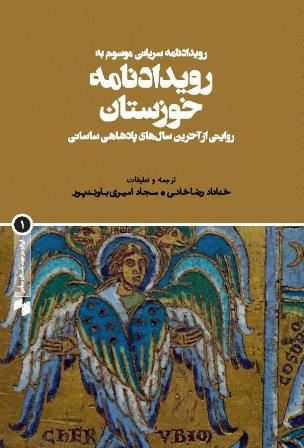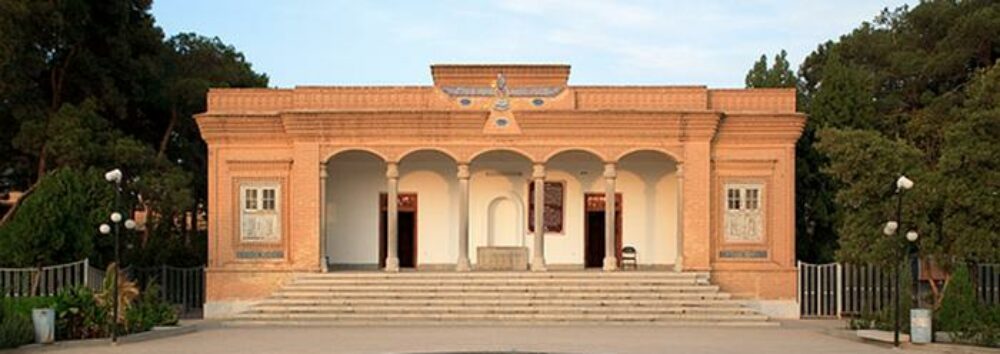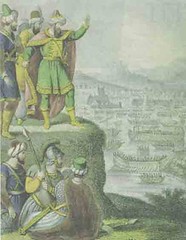
تازگی رویداد نامه خوزستان ( Guidi’s Chronicle) به فارسی ترجمه شده. این رویداد نامه را اسلام شناس ایتالیایی Guidi در سال 1889 معرفی و در سال 1903 به زبان لاتین منتشر کرد. این رویدادنامه را ، به نقل از Cl. Cahen، یک راهب از شرق سوریه در جنوب عراق نوشت ( 1
رویداد نامه به زبان سوری است و در موزه Museo Borgiano di Propaganda Fidi ( ایتالیا )
نگهداری می شود. رویداد نامه از اتفاقات زمان هرمز 4 ( 579 ) تا حمله اعراب به استان خوزستان و تصرف شوشتر ( 650 ) خبر می دهد.
GUIDI’S CHRONICLE, an anonymous, 7th-century chronicle of Nestorian Christians, known also as “the Khuzistan Chronicle,” written in Syriac and covering the period from the reign of the Sasanian Hormizd/Hormoz IV (579-89) to the middle of the 7th century and the time of the early Arab conquests….. preserved in a 14th-century manuscript (Encyclopædia Iranica )
دست نویس رویداد نامه از قرن 14 است. اسلام شناس آلمانی نولدکه این رویداد را در سال 1893 به آلمانی ترجمه کرد. (2
. نولدکه این رویداد نامه را معتبر می داند و ادامه می دهد: این رویداد نامه در سال های 670 تا 680 نوشته شده. اما نولدکه تعجب می کند که نویسنده ” از اتفاقات بعد از حمله اول اعراب خبر نمی دهد و همچنین نویسنده به جنگ های داخلی که شاید خود او شاهد آنها بوده نیز اشاره نمی کند”:
Von den Ereignissen, die nach den ersten Eroberungen der Araber fallen, schweigt er aber fast ganz, so sagt er kein Wort von den Bürgerkriegen , die er doch vielleicht noch selbst erlebt hat
رویدادنامه خوزستان همچنین از فتح آفریقا خبر می دهد و چون آفریقا بعد از سال 650 تسخیر شد می بایست بعد این خبر را نویسنده دیگری به متن اصلی اضافه کرده باشد. Philip Wood اشاره می کند که یک چهارم آخر رویدادنامه خوزستان را نویسنده دیگری نوشت و نویسنده اصلی یک کشیش از مرو به نام الیاس از مرو بود:
The Khuzistan Chronicle is especially significant for its testimony to how history was composed in this era. if we ignore the last quarter of the text, which is a later continuation by another hand , it appears that the author, probably one Elias of Merv, scoured a number of available histories ( and possibly even documentary evidence ) combined this with his own recollection of events to produce history of the past two generations ( 3
نویسنده رویداد خوزستان نامی از یک مذهب جدید، از اسلام، نمی برد و فقط اشاره می کند که اعراب در همان مکانی که ابراهیم یک معبد ساخت خدا را پرستش می کنند و به همین علت نیز اعراب کار جدیدی نمی کنند و فقط سنت قدیمی را ادامه می دهند .
so erbaute er (Abraham ) sich zur verehrung Gottes und zur Darbringung der Opfer jenen Ort, und von diesem früheren Bau hat auch der heutige seine benennung empfangen….Und für die Araber ist es nichts neues dort anzubeten, sondern diese Sitte herrschte schon längs seit alten Tagen
نویسنده اشاره به پسران اسماعیل که دو امپراتوری ( ایران و بیزانس ) را شکست دادند می کند و ادامه می دهد این پیروزی را خدا به آنها داد، اما خدا قسطنطینه را به اعراب نداد:
Der Sieg der Kinder Ismael’s,welche diese beiden mächtigen Reiche überwunden und unterworfen haben, ist von Gott gekommen. Aber über Constantinopel hat ihnen Gott noch keine Gewalt gegeben
خبر محاصره قسطنطینه که اعراب نتوانستند فتح کنند نیز بین سال های 670 تا 680 به متن اصلی اضافه شده و شاید اینجا اشاره ای باشد به حمله ناموفق معاویه به پایتخت بیزانس.
به نقل از رویداد نامه خدا فرزندان اسماعیل که زیاد مانند شن در ساحل دریا بودند به فرماندهی محمد به جنگ ایرانیان فرستاد . اعراب رستم را کشتند و ایران را به تصرف خود درآوردند. بعد اعراب به سوریه حمله می کنند و صد هزار از سربازان هراکلیوس را به قتل می رسانند. به نقل از نولدکه اعراب سوریه را ویران و غارت می کنند.
then God raised up against them the sons of Ishmael numerous as the grains of sand on the sea shore, whose leader was Muhammad (mhmd ) . Neither wall nor gates, armour or shield , withstood gained control over the entire land of the Persians. Yazdgird sent against them countless troops, but the Arab routed them all and even killed Rustam……. They also came to Byzantine territory, plundering and ravaging the entire region of Syria. Heraclius, the Byzantine king, sent armies against them, but the Arabs killed more than 100,000 of them. ( 4
نولدکه ادعا می کند این جنگ در سوریه جنک یرموک بود.
Gemeint ist natürlich die Entscheidungsschlacht am Jarmuk.
این محمد در رویداد خوزستان نمی تواند محمد پیغمبر مسلمانان باشد. اسلام شناس دانمارکی پاتریسیا کرون اشاره می کند:
خبر تاریخی مهم که محمد در حمله به فلسطین شرکت داشته بر خلاف اخبار تاریخ نویسان سنتی است
of greater historical significance is the fact that the prophet is representedas alive at the time of the conquest of palestine. this testimony is of course irreconcilable with the islamic account of the prophet’s career ( 5)
به نقل از نویسندگان ایرانی و عرب حمله اعراب مسلمان به ایران ( جنگ قادسیه ) در سال 636 رویداد و محمد، پیغمبر مسلمانان، در سال 632 درگذشت. از طرف دیگر باستان شناسان اسرائیلی هیچ نشانه ای از ویرانی در محل جنگ یرموک و فلسطین در حفاری ها مشاهده نکردند
رویدانامه خیلی کوتاه به جنگ قادسیه اشاره می کند، اما فقط به قسمت آخر آن، به کشته شدن ژنرال ساسانی رستم و به ساختن شهر کوفه به دست سعد بن ابی وقاص. برعکس نویسنده رویدادنامه خوزستان تاریخ نویسان عرب به طور مشروح و به نوعی حماسی و شاعرانه از این جنگ خبر داده اند “
All the conqauests mentioned by the author do not belong to Muhammad’s time, but were undertaken by his successors: Abu Bakir and Umar ibn al-Khattab . However, the author does not credit either one of these with the conquests, and does not even mention their names in the Chronicle. The chronicle tells briefly about the battle of al-Qadisiyyah, but only in the context of its outcome, namely the death of the Sasanian general Rustum and the founding of the city of Kufa by Saad ibn Waqqas. By contrast, Arab sources discuss at length and with great detail this battle, turning it into epic proportions, and embellishing it with poetry and other stylistic devices (6
رویداد نامه خوزستان خبر می دهد شهروندی که آبراه شوشتر را به اعراب نشان داد ( خیانت کرد ! ) از قطر بود
Then a man from Qatar who lived there became friends with someone who had a haus on the walls, and the two of them conspired together and went out to the Arabs, telling them: “ If you give us a third of the spoil of the city, we will let you into it. “ They made an agreement between them and they dug tunnels inside under the walls, letting in the Arabs, who thus took Shustar, spilling blood there as if were Water ( 7
و در حمله به اسکندریه ( مصر ) نیز یک شهروند قطری راه مخفی به شهر را به اعراب نشان داد. برای نولدکه شگفت آور است که هر دو خائن از قطر بودند:
Wunderlich, das wohl der Verräther Alexanderia’s, wie Suster’s aus Qatar gewesen sein soll !
نویسنده ناشناس رویداد نامه خوزستان از شهر حاصور – Tel-Hazor – ( در شمال منطقه باستانی کنعان، در اسرائیل، در فلسطین امروز ) نام می برد که به عرب ها تعلق دارد و ادامه می دهد حاصور همان مدینه، یا یثرب است. برای نویسنده رویداد نامه خوزستان حاصور در اسرائیل ، در فلسطین همان مدینه در عربستان است.
Hasor, which scripture calls “ hesd of the kingdome „, blongs to the Arab, while Medina is named after Midian, Abraham fourth son by Qetura; it is also called Yathrib (8
مذهب شناس آلمانی کارل هاینس اولیگ اشاره می کند که نویسنده رویدادنامه نمی دانسته پرستشگاه ابراهیم کجا است و به همین علت رجوع می کند به تورات ( در کتاب یوشع به حاصور اشاره شده ) اولیگ ادامه می دهد که رویداد نامه خوزستان در نیمه دوم قرن 8 رونویسی شده، و رونویس بردار یثرب و مدینه را به رویداد نامه اضافه کرده
Der Abschreiber gibt aber Medin / Yatrib an….Er müss vor dem Drittel des 8 Jahrhunderts seine Zugefügung gemacht haben, weil Mekka noch nicht ins Spiel gebraucht wird.( 9
————————————–
1 -Revue de I’Histoire des Religions 2, 1964, 52
2 – Theodor Nöldeke, “Die von Guidi herausgegebene syrische Chronik, übersetzt und commentiert” in Sitzungsberichte der kaiserlichen Akdemie der Wissenschaften, phil.-hist. Kl. 128, 9, Vienna, 1893, pp. 1-48
3 – Philip Wood, The Chronicle of Seert, Christian Historical Imagination in Late Antique Iraq, Oxford University Press 2013, P. 183-4
4 – Robert G. Hoyland, Seeing Islam as others saw it, Princeton, 1997, P. 186
5 – Crone & cook, Hagarism, Cambridge University Press 1977, P. 4
6 – Nasir al-Kabi, A Short Chronicle on the End of the Sasanian Empire and Early Islam 560 -660 A.D., 2016
6 – Robert G. Hoyland , P. 184
7 – Robert G. Hoyland , P. 187-188
8 – Karl-Heiz Ohlig, Der frühe Islam, 2007, Berlin, P. 263


 خشایارشا در جنگ سالامیس
خشایارشا در جنگ سالامیس
با درود، نام زبان بایستی سریانی باشد نه سوری
سوری و سریانی یکی هستند، یک معنی می دهند